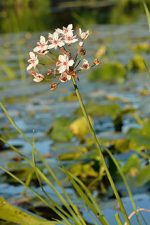 Also called grass rush, this aquatic perennial is native to in Eurasia and Africa where it grows in the margins of still and slowly moving water . It is a member of the Butomaceae, a small family of only one or two species, and is not a true rush. The plants have a rhizomatous root system and grow to about 5′ tall. The linear leaves arise in two rows along the rhizome and are up to 3′ long and twisted. From mid to late summer terminal umbels of 20 to 50 light-pink to rose-colored, scented flowers appear. Each flower is about 1″ across and has 3 petals and 3 petaloid, slightly smaller sepals. The fruit is a many-seeded capsule that ripens from late summer to early fall. The plants are very attractive in a water garden and were brought from Europe to the US as an ornamental but have become invasive in the Great Lakes region and parts of the Pacific Northwest. The genus name, Butomos, comes from the Greek words bous meaning ox and tomos meaning cutting, and refer to the sharp edges of the leaves. The specific epithet, umbellatus, is from the Latin umbra word meaning shield from the sun. The diminutive of the word, umbellata, was applied to the the umbrella which has many spokes originating in one place giving rise to the use of the word for inflorescences resembling an umbrella.
Also called grass rush, this aquatic perennial is native to in Eurasia and Africa where it grows in the margins of still and slowly moving water . It is a member of the Butomaceae, a small family of only one or two species, and is not a true rush. The plants have a rhizomatous root system and grow to about 5′ tall. The linear leaves arise in two rows along the rhizome and are up to 3′ long and twisted. From mid to late summer terminal umbels of 20 to 50 light-pink to rose-colored, scented flowers appear. Each flower is about 1″ across and has 3 petals and 3 petaloid, slightly smaller sepals. The fruit is a many-seeded capsule that ripens from late summer to early fall. The plants are very attractive in a water garden and were brought from Europe to the US as an ornamental but have become invasive in the Great Lakes region and parts of the Pacific Northwest. The genus name, Butomos, comes from the Greek words bous meaning ox and tomos meaning cutting, and refer to the sharp edges of the leaves. The specific epithet, umbellatus, is from the Latin umbra word meaning shield from the sun. The diminutive of the word, umbellata, was applied to the the umbrella which has many spokes originating in one place giving rise to the use of the word for inflorescences resembling an umbrella.
Type: Aquatic perennial
Bloom: Terminal umbels of 20 to 50 light-pink to rose-colored scented flowers in mid to late summer
Size: 5′ H
Light: Full sun
Soil: Wet
Hardiness: Zones 4-10
Care: Watch carefully and prevent unwanted spread
Pests and Diseases: Susceptible to Pestalotiopsis guepinii, Steyaert, Virgaria nigra,
Hansfordia ovalispora, Fusarium oxysporum, and Phoma sp.
Propagation: Fresh seed, fragmentation of root system
Companion Plants: Water lilies, water lettuce, cardinal flower
Outstanding Selections: None available
Photo Credit: Wikipedia